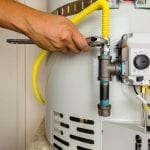Specialist Guidance for Caring for Your Home's Hot Water SystemEasy Ways to Maintain Your Home's Hot Water System Properly
Specialist Guidance for Caring for Your Home's Hot Water SystemEasy Ways to Maintain Your Home's Hot Water System Properly
Blog Article
We've stumbled on this great article about How to Maintain a Hot Water Heater in a Few Simple Steps listed below on the internet and think it made perfect sense to relate it with you here.

Warm water is necessary for day-to-day convenience, whether it's for a rejuvenating shower or washing recipes. To guarantee your warm water system runs effectively and lasts longer, normal upkeep is crucial. This short article gives practical tips and understandings on exactly how to maintain your home's hot water system to stay clear of disturbances and pricey repair work.
Introduction
Maintaining your home's warm water system could appear complicated, but with a couple of easy actions, you can ensure it runs smoothly for several years ahead. This overview covers everything from recognizing your hot water system to do it yourself maintenance tips and recognizing when to hire specialist help.
Relevance of Preserving Your Warm Water System
Routine upkeep not only expands the life expectancy of your warm water system but additionally ensures it runs efficiently. Disregarding maintenance can bring about decreased performance, higher power bills, and also early failure of the system.
Indicators Your Warm Water System Requirements Upkeep
Recognizing when your hot water system requires attention can prevent significant problems. Look out for indicators such as inconsistent water temperature level, odd noises from the heating system, or corroded water.
Comprehending Your Warm Water System
Before diving into upkeep jobs, it's useful to recognize the fundamental parts of your hot water system. Typically, this includes the hot water heater itself, pipes, anode poles, and temperature controls.
Month-to-month Maintenance Tasks
Normal monthly checks can assist catch small issues before they intensify.
Purging the Water Heater
Purging your water heater gets rid of sediment accumulation, improving effectiveness and lengthening its life.
Checking and Replacing Anode Rods
Anode poles prevent rust inside the container. Examining and changing them when worn out is vital.
Examining and Readjusting Temperature Settings
Changing the temperature level setups makes certain optimum efficiency and safety.
DIY Tips for Upkeep
You can execute several maintenance tasks yourself to keep your hot water system in top condition.
Checking for Leaks
Frequently examine pipes and links for leakages, as these can cause water damages and greater bills.
Evaluating Pressure Relief Valves
Testing the pressure relief valve ensures it functions appropriately and protects against excessive stress build-up.
Insulating Pipelines
Shielding warm water pipelines lowers warmth loss and can save energy.
When to Call a Professional
While DIY maintenance is beneficial, some issues require professional competence.
Complex Issues Requiring Professional Aid
Instances consist of major leaks, electrical problems, or if your water heater is regularly underperforming.
Regular Specialist Upkeep Conveniences
Professional maintenance can include complete examinations, tune-ups, and making certain conformity with security criteria.
Verdict
Routine upkeep of your home's warm water system is vital for efficiency, long life, and price financial savings. By complying with these ideas and understanding when to seek professional help, you can make certain a trusted supply of hot water without unforeseen disruptions.
Water Heater Maintenance: The Basics
Maintaining your water heater will ensure it operates efficiently and has a longer lifespan. Neglecting regular maintenance can lead to costly repairs and an even bigger chunk of your savings if you have to replace it sooner than necessary. But there’s good news: Most water heater maintenance tasks are relatively simple and easy for homeowners with basic DIY skills.
Flush the Water Heater
Over time, sediment and minerals can build up in the tank, reducing its efficiency and potentially causing damage. To flush the tank, turn off the power or gas supply, attach a hose to the drain valve near the bottom and open the valve to drain the water until it runs clear. Ideally, flush the tank annually.
Replace the Anode Rod
The anode rod is a sacrificial metal rod that helps prevent corrosion inside the tank. Inspect and replace it every three to five years or per the manufacturer's recommendation. To replace the anode rod, turn off the power or gas supply, drain a few gallons of water from the tank, unscrew the old rod and replace it with a new one. If the anode rod is significantly corroded or covered in calcium buildup, it's a sign the water heater may need to be replaced soon.
Tune-Up
A yearly tune-up can help identify potential issues and ensure your water heater operates at peak efficiency. This typically involves checking the thermostat, burner assembly (for gas heaters) and any other components specified by the manufacturer. During a tune-up, the technician may also clean the burner and adjust the pilot light (for gas heaters) or examine the heating elements (for electric heaters).
How to Maintain Your Water Heater
Insulate the tank. Insulating the tank can improve energy efficiency and reduce heat loss, saving you money on energy bills. You can purchase precut insulation blankets designed specifically for water heaters or use standard fiberglass insulation wrapped securely around the tank. Check the temperature. The recommended water temperature for most households is around 120 degrees Fahrenheit (49 degrees Celsius). Higher temperatures can increase energy costs and potentially cause scalding. Use a kitchen thermometer to check the temperature at the faucet nearest the water heater. Monitor water pressure. Excessive water pressure can strain the water heater and cause leaks or even tank failure. Install a pressure-reducing valve if necessary. The ideal water pressure range is between 60 and 70 PSI (pounds per square inch). Test the temperature and pressure (T&P) relief valve. The T&P relief valve is a safety feature that releases pressure if the tank gets too hot or the pressure builds up too high. Test it annually by lifting the lever and allowing a small amount of water to release. Replace the valve if it doesn't release water or reseal properly. Check for leaks. Regularly inspect the tank, pipes and fittings for leaks or corrosion. Deal with issues promptly to prevent further damage. Even a small leak can lead to significant water damage over time. Consider a tankless water heater. If your traditional tank-style water heater is nearing the end of its lifespan ( typically 10 years), consider replacing it with a tankless water heater. These units heat water on demand, reducing standby energy losses and potentially saving you money on your energy bills. Schedule professional maintenance. While homeowners can perform many water heater maintenance tasks, it's still a good idea to schedule professional maintenance every few years. A plumber or HVAC technician can thoroughly inspect the unit, identify potential issues and ensure it operates safely and efficiently. https://www.homeserve.com/en-us/blog/home-improvement/hot-water-heater-maintanence/

Hopefully you enjoyed reading our topic on Tips on Maintaining a Water Heater. Thanks so much for spending some time to read through our blog. Kindly set aside a second to distribute this article if you appreciated it. I am grateful for your time. Return soon.
Call Today Report this page